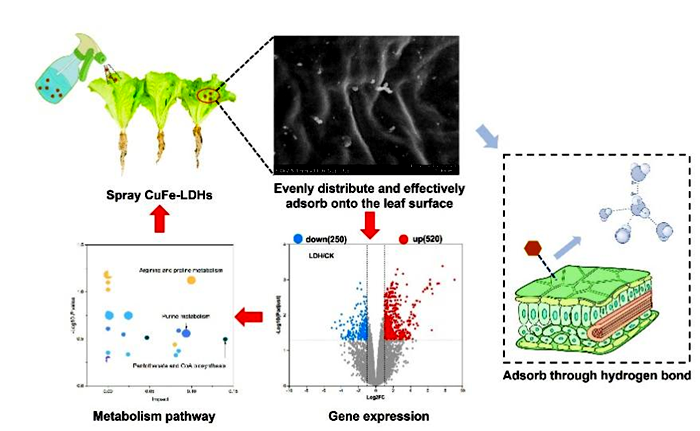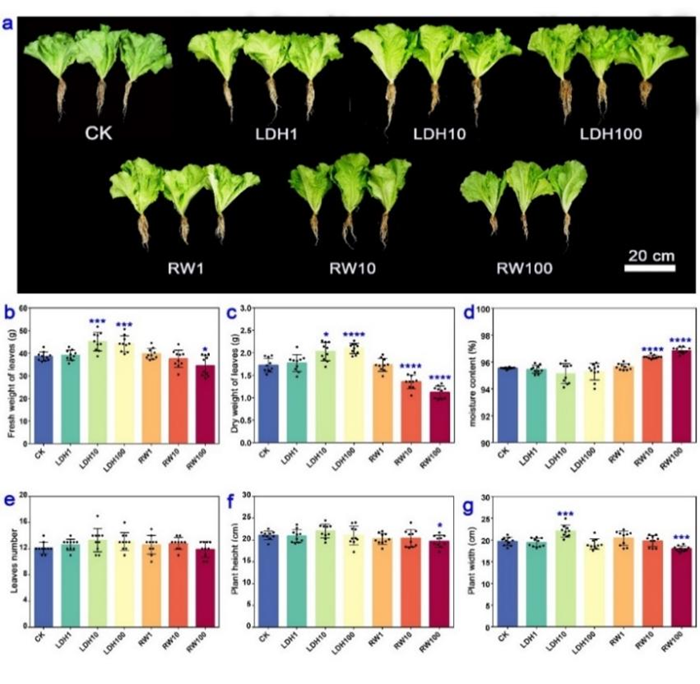Enhanced lettuce yield through nanoparticles spraying: expanding the application scope of layered double hydroxides
Recently, the innovation team of vegetable cultivation and physiology of the Institute of Vegetables and Flowers (IVF) of the Chinese Academy of Agricultural Sciences (CAAS) published a research paper entitled "Enhancing Lettuce Yield via Cu/Fe-Layered Double Hydroxide Nanoparticles Spraying" in the journal Journal of Nanobiotechnology .
Layered double hydroxides (LDHs) are a two-dimensional nanomaterial with various applications in the field of life sciences. They are characterized by their facile synthesis, flexible structure regulation, excellent biocompatibility, low-cost, negligible cytotoxicity, facile biodegradation, and the tunable release of encapsulated cargoes. LDHs have been widely used in the field of plant engineering, such as DNA/RNA transformation and enhancing plant disease resistance. However, few studies have examined the direct effects of LDHs on plants and their potential utility as nanofertilizers.

Fig. 1 Schematic diagram of CuFe-LDHs promoting lettuce growth
This study investigated the adsorption capacity of CuFe-LDHs in various vegetables and found that it had higher retention in leafy vegetables, such as lettuce, due to the formation of hydrogen bonds between the hydroxyl (-OH) groups in LDHs structure and the leaf surface. The application of 10-100 μg/mL CuFe-LDHs significantly increased lettuce yield, while the same concentration of synthetic raw materials (copper and iron heavy metal salts) inhibited lettuce growth, indicating that nanocrystallization can reduce heavy metal ion toxicity. Further experiments using CuFe-LDHs at an optimal concentration of 10 μg/mL revealed that it had a significant effect on growth of lettuce by inducing changes in physiological indicators, transcriptome, and metabolome, including an increase in chlorophyll b content, net photosynthetic rate, and intercellular carbon dioxide concentration, as well as changes in gene expression patterns and metabolic profiles. This study demonstrated that CuFe-LDHs could efficiently adsorb onto lettuce leaves through hydrogen bonds, promote lettuce growth, alleviate the toxicity of heavy metal ions (Cu2+, Fe3+) compared with the same concentration of raw materials, and explored the mechanism of CuFe-LDHs promoting growth from the perspective of physical effects of CuFe-LDHs structure on plants and plant physiology and molecular biology. This research deepened the understanding of the mechanism of LDHs promoting growth and provided a solid experimental basis for developing LDHs-based nanofertilizers to improve vegetable yields.

Fig. 2 Effect of spraying different concentrations of CuFe-LDHs and RW on the phenotype of lettuce after one month.
This work was funded by the National Key Research and Development Program, and the National Natural Science Foundation of China.
More information can be found through the link: https://doi.org/10.1186/s12951-023-02178-6
By Hongyang Wu (wuhongyang@caas.cn)
-
 Apr 18, 2024Opening Ceremony of the Training Workshop on Wheat Head Scab Resistance Breeding and Pest Control in Africa Held in CAAS
Apr 18, 2024Opening Ceremony of the Training Workshop on Wheat Head Scab Resistance Breeding and Pest Control in Africa Held in CAAS -
 Apr 03, 2024IPPCAAS Co-organized the Training Workshop on Management and Application of Biopesticides in Nepal
Apr 03, 2024IPPCAAS Co-organized the Training Workshop on Management and Application of Biopesticides in Nepal -
 Mar 28, 2024Delegation from the School of Agriculture and Food Science of University College Dublin, Ireland Visit to IAS, CAAS
Mar 28, 2024Delegation from the School of Agriculture and Food Science of University College Dublin, Ireland Visit to IAS, CAAS -
 Mar 25, 2024Director of World Food Prize Foundation visited GSCAAS
Mar 25, 2024Director of World Food Prize Foundation visited GSCAAS -
 Mar 20, 2024Institute of Crop Sciences (ICS) and Syngenta Group Global Seeds Advance Collaborative Research in the Seed Industry
Mar 20, 2024Institute of Crop Sciences (ICS) and Syngenta Group Global Seeds Advance Collaborative Research in the Seed Industry
